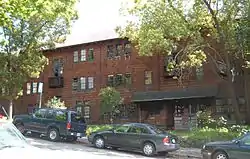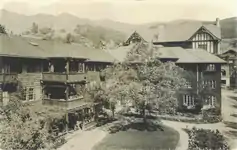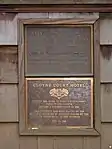Cloyne Court Hotel
The Cloyne Court Hotel, often referred to simply as Cloyne, is one of the houses of the Berkeley Student Cooperative (BSC), a student housing cooperative in Berkeley, California.[3] It is located at the north side of the University of California, Berkeley campus at 2600 Ridge Road,[3] near Soda Hall and Jacobs Hall, and is the next door neighbor of Goldman School of Public Policy.
Cloyne Court Hotel | |
Berkeley Landmark No. 65 | |
 | |
   | |
| Location | 2600 Ridge Rd., Berkeley, California |
|---|---|
| Coordinates | 37°52′33″N 122°15′26″W |
| Area | less than one acre |
| Built | 1904 |
| Architect | John Galen Howard |
| Architectural style | San Francisco Bay Tradition |
| NRHP reference No. | 92001718[1] |
| BERKL No. | 65 |
| Significant dates | |
| Added to NRHP | December 24, 1992 |
| Designated BERKL | November 15, 1982[2] |
Description
Cloyne is the largest non-apartment style property in the BSC,[4] itself the largest housing co-op organization in North America,[5] housing 140 UC Berkeley students (119 during summer),[3] mostly undergraduates. Despite its size the house is student-run and student-governed. Members contribute 5 hours of workshift per week each for various tasks needed for the operation of the house: cooking, cleaning, house maintenance, gardening, etc. Since July 2005, a facility manager employed by the students and the BSC lives on the premises to help with day-to-day operations of the house. Every weekday and on Sundays members cook a communal dinner, and on Saturdays there is a communal brunch. House's council, house's governing body where all members democratically make decisions pertaining the house, meets every Sunday.
Similar to other BSC houses it has a specific theme and culture. It has been academic themed and substance-free since 2014. As part of the theme it has an increased number of study rooms, a library, a makerspace/hackerspace (a rare case where members can both hack and live in the same building),[6] and many lectures given by guest lecturers and members themselves. A common practice is also informal visits of UC Berkeley professors at communal dinners, allowing members to get to know them also through a less formal setting. An example of a UC Berkeley faculty member visiting Cloyne is popular EECS professor John DeNero, who regularly presented about the joys of data for many semesters.
Cloyne is substance-free. Possession and use of controlled substances is not allowed on premises. Similar to other BSC houses, students who prefer such environment choose to live in the house when selecting between all BSC houses.
Cloyne is known for its murals covering many of its internal walls. Murals have been made through years by members residing in the house. The building is one of fifty-six buildings in Berkeley listed in the National Register of Historic Places as well as a City of Berkeley Landmark.[7]
History
Cloyne Court was named after Cloyne, the village in Ireland where George Berkeley was bishop.
Cloyne was built in 1904 for $80,000 by the University Land and Improvement Company, which included several University professors, University benefactresses Phoebe Apperson Hearst and Jane K. Sather, future Regent James K. Moffit, Dr. Louis Lisser, John L. Howard, Warren Olney, Dr. Kasper Pishel, Louis Titus, John Galen Howard, the architect of the building and James M. Pierce, the later owner of the hotel. The building, described as a "high-class, modern apartment house," originally contained 32 suites, each with bath, that were not connected by common hallways, but rather were paired onto private stairways to the first floor public areas. Each section was separated by heavy brick firewalls with automatic fireproof doors and each suite was wired for telephone. In 1911, the music room (today called lib-ed room) was added to the building, directly opposite the main entrance, which hosted numerous lectures and music recitals.
The building was one of a rare few to survive the devastating 1923 Berkeley fire, remarkable also because the building is made of redwood and all of the buildings had (and still have) wood shake siding and roofs.[8]
Pierce and his family managed the hotel from its opening in 1904 until 1914, when they purchased it from the investors. The family continued operating the hotel until it was sold in 1946.
The services and hospitality at Cloyne Court were always highly complimented by the many visitors who had the pleasure of staying at the hotel. Registered compliments in the hotel guest book include:
- Cloyne Court - Silence and peace in an insane world. - Ernest Bloch, 1944
- Cloyne Court, a haven and a place where the gentle art of hospitality is made manifest to the unknown stranger as well as to the great ones of our day. - Mary Lambert, 1942
- Giving people a happy home is a divine service. - Benjamin Ide Wheeler, 1923
- I came a stranger, stayed a guest and departed a friend. - unknown
Cloyne Court was sold by the Pierce family in 1946 to the University Students' Cooperative Association (today BSC) for $125,000. That year, 15 men occupied the new co-op house alongside the previous residents, whom the USCA had agreed to not displace but rather to allow to continue to live in the former residential hotel. Cloyne originally housed all men who often held dances and dined with the women of nearby Stebbins Hall and Hoyt Hall, both all-female co-ops at the time. In 1972, Cloyne Court became a co-ed house.
In 1970, the USCA was forced to sell the property to the Regents of the University of California, upon the threat of an eminent domain acquisition by the University, in exchange for a peppercorn lease, most recently renewed in July 2005.[9]
On December 21, 2008, Cloyne Court was closed temporarily for earthquake renovations. It reopened at the beginning of the Fall 2009 semester.
Music scene
In the past, Cloyne has played a notable role in the Bay Area music scene. The bands No Doubt, Operation Ivy, The Offspring, Rancid, Green Day, Primus, Elliott Smith, 24-7 Spyz, Save Ferris, Skankin' Pickle, The Mr. T Experience, Two Gallants, Blüchunks and Rilo Kiley played at Cloyne before becoming well known. The house has also been host to several lesser-known bands during its many events. Cloyne has hosted as many as a dozen bands in a single evening, commonly using 2 separate stages, though sometimes as many as 4: the dining room, the lib-ed room, the basement, and the courtyard.
Cultural shift
In the past, Cloyne has been known for its party and rules-free culture. This became a problem for the entire organization when in 2010 John Gibson, then a 21-year-old resident, suffered extensive brain damage and lapsed into a coma, reportedly as a result of a cocaine overdose, in his room.[10][11][12] A lawsuit followed his hospitalization, his family claiming his fellow housemates failed to call 911 in time to assist him. The BSC settled with his family with the agreement that Cloyne would dramatically change. Prior members were forced to leave, but one member was allowed to stay after appeal. Beginning in Fall 2014, the house became substance-free and academic themed.
Gallery
References
- "National Register Information System". National Register of Historic Places. National Park Service. March 13, 2009.
- "Berkeley Landmarks". Berkeley Architectural Heritage Association. Retrieved 2013-03-04.
- Berkeley Student Cooperative. "Cloyne Court". Berkeley Student Cooperative. Berkeley Student Cooperative. Archived from the original on 2013-06-06. Retrieved January 23, 2019.
- Berkeley Student Cooperative (February 8, 2015). "Ownership Status". BSC Policy Wiki. Berkeley Student Cooperative. Archived from the original on 2019-01-19. Retrieved January 23, 2019.
- O'Connor, Lydia (17 March 2014). "Bad News For America's Largest Housing Co-Op". HuffPost. Archived from the original on 10 September 2019. Retrieved 10 September 2019.
- "Cloyne hackerspace". Cloyne.
- http://nrhp.focus.nps.gov/natregsearchresult.do?fullresult=true&recordid=14
- "September 17, 1923: The Day That Berkeley Burned". Cal Alumni Association. 2019-03-26. Archived from the original on 2020-11-27. Retrieved 2021-01-19.
- Lillian, III, Guy H. "Cheap Place to Live". Cheap Place to Live.
- "Details Surrounding Student's Overdose Emerge, The Daily Californian, August 5, 2010
- "Tragedy puts UC Berkeley house in spotlight," San Francisco Chronicle, August 1, 2010
- "UC Berkeley co-ops begin novel campaign on drugs," San Francisco Chronicle, March 18, 2011
Sources
- Bender, Richard, Director. Campus Historic Resources Inventory, Berkeley University of California Planning Office, 1978.
- Brechin, Gray. "Architectural heritage..." The Berkeley Gazette. 12 January 1977.
- Cloyne Court Collection, ms. no. 75/35 c Bancroft Library, University of California.
- City of Berkeley Landmark Application compiled by Anthony Bruce. 20 September 1982.
- National Register of Historic Places Registration Form, compiled by Charles Bucher, Jr. with revisions and editing by Susan Cerny and Lesley Emmington. 8 June 1992.
External links
| Wikimedia Commons has media related to Cloyne Court Hotel. |
- Official Website
- Cloyne's BSC webpage
- Cloyne hackerspace
- History of the Cloyne Court Hotel, from the Berkeley Architectural Heritage Association
- Cloyne Court co-op history, from Cheap Place to Live by Guy H. Lillian, III
- Cloyne Court, 1966 - 1970: a Personal History - Ted Pack
- The Cloyne Court Forum - a free forum for all
- well.com/user/calton/text/cloyne.html
- http://profileengine.com/groups/profile/431037357/cal-cloyne-court-19801987%5B%5D
- Cloyne Court Co-op House Manager 1986-87
- Big Co-op Houses - Google Groups
- Cloyne Court: Historic Structures Report, Preservation Architecture, July 27, 2007
- Last remaining member of old Cloyne Court prepares to leave - Daily Californian


.JPG.webp)
.jpg.webp)
.jpg.webp)
.jpg.webp)

